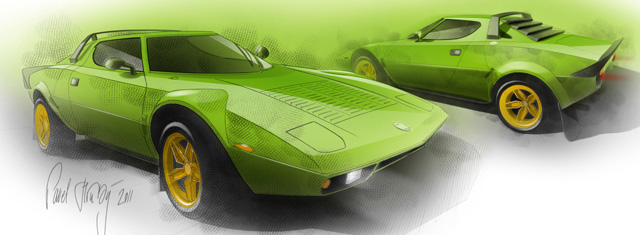 |
|
|
Název rubriky |
fin | Lancia Stratos HF |
| Název článku | Horizon Full |
| Autor článku | Pavel Hrubý |
| architekt | designér | |
| Místo původu | Itálie | Turín | Grugliasco |
| Výrobce | Bertone |
| Designér |
Marcello Gandini – narozen 1938 (šéfdesignér Bertone 1965-1979) |
| Chronologie | 1906 založení společnosti Lancia |
| 1912 založení společnosti Carrozzeria Bertone | |
| 1970 představení konceptu Lancia Stratos Zero | |
| 1971 představení prototypu Lancia Stratos HF | |
| 1972 představení sériové verze Lancia Stratos HF | |
| 1973 zahájení výroby Lancie Stratos HF | |
| 1974 zisk titulu v mistrovství světa v rallye | |
| 1974 ukončení výroby Lancie Stratos HF | |
| 1975 zisk titulu v mistrovství světa v rallye | |
| 1976 zisk titulu v mistrovství světa v rallye | |
| Name of the rubric |
fin | Lancia Stratos HF |
| Article title | Horizon Full |
| Autor of the article |
Pavel Hrubý |
| architect | designer | |
|
|
|
| Place of origin | Italy | Torino | Grugliasco |
| Producer | Bertone |
| Designer | Marcello Gandini – born 1938 (chefdesigner of Bertone 1965-1979) |
| Chronology |
1906 founding of the Lancia company |
|
1912 founding of the Carrozzeria Bertone company |
|
|
1970 performances of Lancia Stratos Zero |
|
| 1971 performances of Lancia Stratos HF prototype | |
| 1972 performances of Lancia Stratos HF | |
| 1973 start of Lancia Stratos HF production | |
| 1974 winner of the World Rally Championship | |
| 1974 end of Lancia Stratos HF production | |
| 1975 winner of the World Rally Championship | |
| 1976 winner of the World Rally Championship | |
|
Když karosářské studio Bertone v roce 1970 představilo studii Lancia Stratos Zero, málokdo si připustil, že by z tak futuristicky vyhlížejícího konceptu mohla vzejít legenda automobilového rallye sportu. A přece se tak stalo...
Manažera závodní stáje Lancia tato myšlenka skutečně napadla a společně s Marcellem Gandinim v čele studia Bertone připravili poprvé v historii soutěžní speciál přímo pro závodní tratě mistrovství světa. Nové dvoumístné kupé Lancia Stratos HF (označení HF bylo odvozeno ze slovního obratu závodních jezdců „horizon full“) se původní předlohou pouze inspirovalo, i nadále ale vynikalo svou odvážně aerodynamicky řešenou 3708 mm dlouhou klínovitou karosérií.
Dalším trumfem Stratosu HF byla pohonná jednotka. V roce 1969 se totiž Lancia stala součástí koncernu Fiat a namísto původně plánovaného motoru předchůdce byl před jeho zadní nápravu příčně usazen výkonný šestiválec Ferrari s objemem 2418 cm3 a výkonem 140 kW. Zadní hnaná náprava automobilu s pohotovostní hmotností necelé tuny tak dokázala vytáhnout ručičku rychloměru až k hodnotě 225 km/h.
V průběhu své závodní kariéry tento vůz získal nejen nekonečnou řadu dílčích vítězství, stal se ale především trojnásobným celkovým vítězem mistrovství světa v rallye v letech 1974 až 1976. Podmínkou Mezinárodní automobilové federace (FIA) pro homologaci na světové soutěže byla výroba omezené série Lancie Stratos HF, a tak tento skvost vznikl v necelých pěti stech exemplářích a doputoval i do rukou mnoha motoristických nadšenců.
When Bertone bodyworks studio introduced the Lancia Stratos Zero concept in 1970, not many believed such a futuristic looking concept could ever become a legend of automotive rally sport. And yet it happened...
Lancia racing team manager really did have this idea and together with Marcello Gandini at the head of Bertone studio, they prepared a racing special directly for the World Championship tracks for the first time in history. The new two-seat coupe Lancia Stratos HF (HF was derived from the phrase of racing drivers ‘horizon full’) was only inspired by the original model, but still stood out boldly with its aerodynamic solution of a 3708 mm long wedge-shaped body.
Another triumph for the Stratos HF was its power unit. In 1969, Lancia became part of Fiat concern and instead of the originally planned engine of its predecessor, in front of its rear axle was a laterally placed powerful Ferrari six-cylinder with 2418 ccm of volume and 140 kW of power. With a curb weight of under a ton, the car’s rear drive axle managed to take the hand of the speedometer all the way to 225 km/h.
During its racing career, this car not only gained a never ending series of individual victories, but also mainly became a triple overall winner of the World Rally Championship from 1974 to 1976. A requirement of the International Auto Federation (FIA) for approval into the World Championships was production of the Lancia Stratos HF in a limited series, and so this jewel came out in less than five hundred specimens and went out into the hands of many motorism enthusiasts. |
|
| fotografie lze zvětšit do pohledové velikosti / photos are presented in a detail | ||||||||
 |
 |
 |
 |
|||||